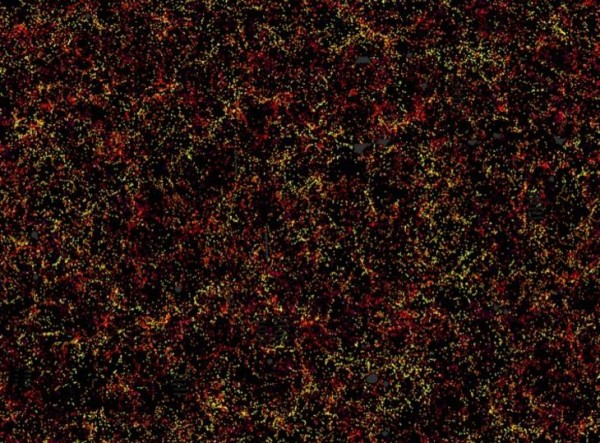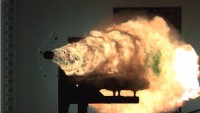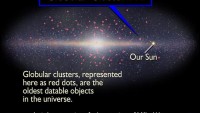Scientists Measure Dark Energy with Record-breaking Map of 1.2 Million Galaxies
| Arthur Dominic Villasanta | | Jul 15, 2016 09:16 AM EDT |
(Photo : Daniel Eisenstein and SDSS-III) Each dot in this picture indicates the position of a galaxy 6 billion years into the past.
A massive effort by hundreds of physicists and astronomers has created the most precise measurements yet of the dark energy currently driving the accelerated expansion of the Universe.
The measurement was derived from a record-breaking map of 1.2 million galaxies, which is the largest-ever, three-dimensional map of distant galaxies.
Like Us on Facebook
"We have spent five years collecting measurements of 1.2 million galaxies over one quarter of the sky to map out the structure of the Universe over a volume of 650 cubic billion light years," said Jeremy Tinker of New York University, a co-leader of the scientific team carrying out this effort.
"This map has allowed us to make the best measurements yet of the effects of dark energy in the expansion of the Universe. We are making our results and map available to the world."
These new measurements were carried out by the Baryon Oscillation Spectroscopic Survey (BOSS) program of the Sloan Digital Sky Survey-III (SDSS III). SDSS-III's BOSS is designed to measure the expansion rate of the Universe.
The map revealed by BOSS allows scientists to measure the expansion rate of the Universe and determine the amount of matter and dark energy that comprise the present-day Universe.
BOSS measures the expansion rate of the Universe by determining the size of the baryonic acoustic oscillations (BAO) in the three-dimensional distribution of galaxies. The original BAO size is determined by pressure waves that travelled through the young Universe up to when it was only 400,000 years old. At this point they became frozen in the matter distribution of the 13.8 billion year-old Universe.
The end result is that galaxies have a slight preference to be separated by a characteristic distance that astronomers call the acoustic scale.
The size of the acoustic scale at 13.4 billion years ago has been determined from observations of the cosmic microwave background (CMB) from the light emitted when the pressure waves became frozen.
Measuring the distribution of galaxies since that time allows astronomers to measure how dark matter and dark energy have competed to govern the rate of expansion of the Universe.
"We've made the largest map for studying the 95% of the universe that is dark," noted David Schlegel, an astrophysicist at Lawrence Berkeley National Laboratory (Berkeley Lab) and principal investigator for BOSS.
"In this map, we can see galaxies being gravitationally pulled towards other galaxies by dark matter. And on much larger scales, we see the effect of dark energy ripping the universe apart."
Shirley Ho, an astrophysicist at Berkeley Lab and Carnegie Mellon University (CMU), co-led two of the companion papers and adds, "We can now measure how much the galaxies and stars cluster together as a function of time to such an accuracy we can test General Relativity at cosmological scales."
Ariel Sanchez of the Max-Planck Institute of Extraterrestrial Physics led the effort to estimate the exact amount of dark matter and dark energy based on the BOSS data. He said measuring the acoustic scale across cosmic history "gives a direct ruler with which to measure the Universe's expansion rate. With BOSS, we have traced the BAO's subtle imprint on the distribution of galaxies spanning a range of time from 2 to 7 billion years ago."
At the time the BOSS program was planned, dark energy had been previously determined to significantly influence the expansion of the Universe starting about 5 billion years ago. BOSS was thus designed to measure the BAO feature from before this point (7 billion years ago) out to near the present day (2 billion years ago).
Tagsdark energy, map of 1.2 million galaxies, Jeremy Tinker, Baryon Oscillation Spectroscopic Survey, Universe, Sloan Digital Sky Survey-III
©2015 Chinatopix All rights reserved. Do not reproduce without permission
EDITOR'S PICKS
-

Did the Trump administration just announce plans for a trade war with ‘hostile’ China and Russia?
-

US Senate passes Taiwan travel bill slammed by China
-

As Yan Sihong’s family grieves, here are other Chinese students who went missing abroad. Some have never been found
-

Beijing blasts Western critics who ‘smear China’ with the term sharp power
-

China Envoy Seeks to Defuse Tensions With U.S. as a Trade War Brews
-

Singapore's Deputy PM Provides Bitcoin Vote of Confidence Amid China's Blanket Bans
-

China warns investors over risks in overseas virtual currency trading
-

Chinese government most trustworthy: survey
-

Kashima Antlers On Course For Back-To-Back Titles
MOST POPULAR
LATEST NEWS
Zhou Yongkang: China's Former Security Chief Sentenced to Life in Prison

China's former Chief of the Ministry of Public Security, Zhou Yongkang, has been given a life sentence after he was found guilty of abusing his office, bribery and deliberately ... Full Article
TRENDING STORY

China Pork Prices Expected to Stabilize As The Supplies Recover

Elephone P9000 Smartphone is now on Sale on Amazon India

There's a Big Chance Cliffhangers Won't Still Be Resolved When Grey's Anatomy Season 13 Returns

Supreme Court Ruled on Samsung vs Apple Dispute for Patent Infringement

Microsoft Surface Pro 5 Rumors and Release Date: What is the Latest?














